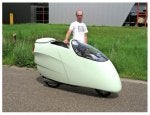I have been reading about the Craig Vetter fuel economy challenge over the past few weeks and have kind of really been wanting to build a streamliner fairing for the reb. I am completely fascinated with converting the reb to a streamliner. An all weather vehicle that offers rideability and the cold and rainy days [I will ride in the rain, and I will ride in the cold, but cold rain? Not gonna happen.] I also like the idea of increased storage for luggage because I plan on traveling to Oregon from Texas with it this March. As opposed to the current streamliner entries, I want to make it completely enclosed and to be able to heat it in the winter months using the heat from the engine [since the alternator can't pump a terrible amount of electricity.] I would also like to build/set solar cells into the body to generate extra power and tender the battery while it is parked, powering a small heater in the winter and perhaps an evaporation cooler/vent fan in the summer to be running when the battery isn't being tendered.
I am going to track my progress in this thread.
Ready set go!
I am going to track my progress in this thread.
Ready set go!









